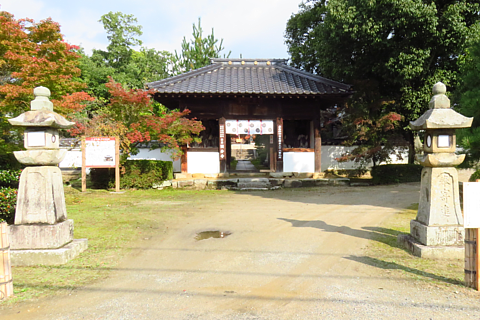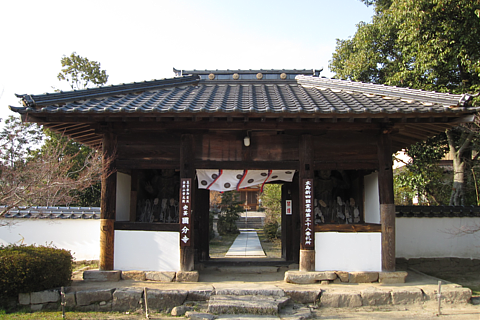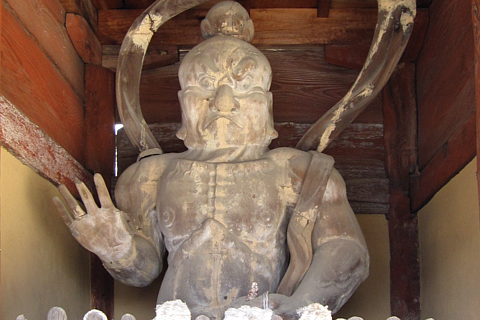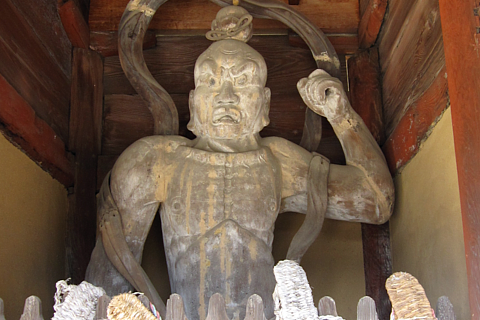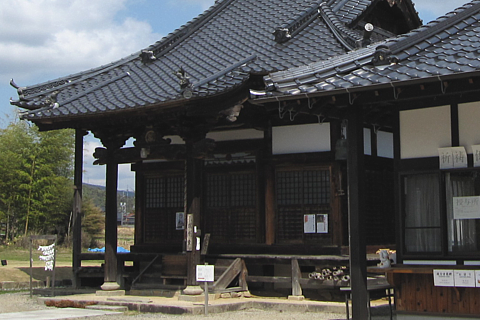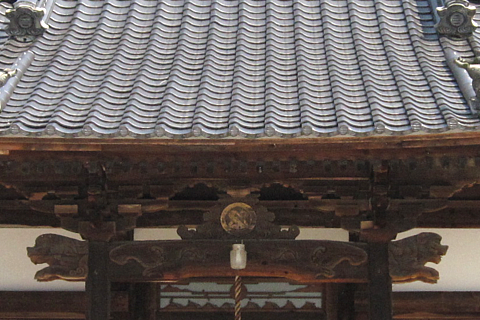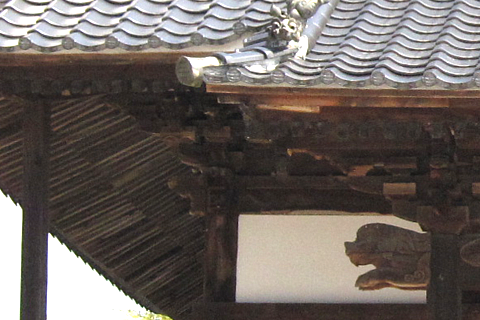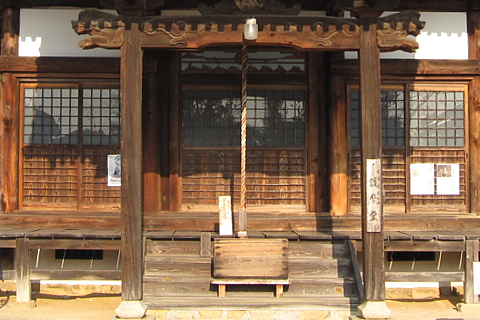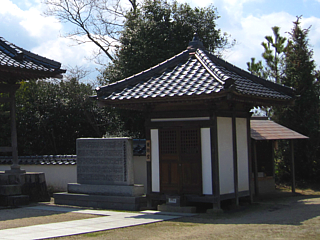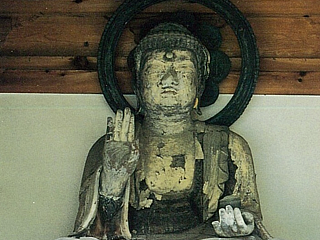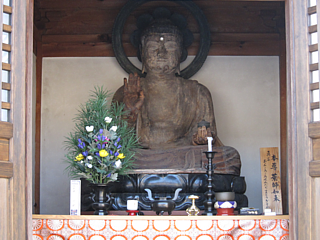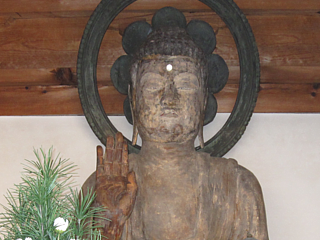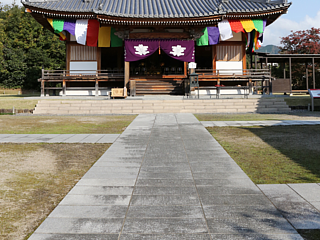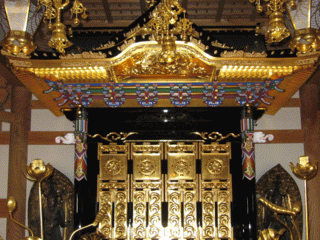文化財
Cultural property
仁王門
平成11年2月18日指定 市重要文化財
國分寺仁王門は、間口3間、奥行2間の典型的な八脚門(3間1戸)で、桁行5.4メートル、梁間3.1メートルを測ります。柱は全て円柱を用いており、棟通りに扉を吊っています。
両脇の後方間には仁王像が安置され、前方間は土間としてつくられれ、仁王像への礼拝場とする平面形式を採っています。こうした形式は、中世期に一部の仁王門で用いられたものです。また、門の形状は柱上舟肘木を置くだけの極めて簡素な意匠です。
当初の屋根は、茅葺(かやぶき)きか、檜皮葺(ひわだぶき)であったと考えられますが、明治期に桟瓦葺に改められ近年にも桟瓦の葺き替えが行われています。扉は江戸時代、天井と垂木より上は近年の材ですが、柱や舟肘木さらに一部の貫が当初材です。このように数度の修造が行われていますが、建立年代は、部材の経年劣化と建築意匠上から16世紀中期と考えられます。
東広島市内で唯一現存する中世の大規模な建造物であり、当時の安芸国分寺を考える上で貴重なものです。
なお、『八箇国御時代分限帳』によると、文禄年間(1592~95)に安芸国分寺は、毛利氏より30石の所領を与えられていました。
護摩堂
平成11年2月18日指定 市重要文化財
護摩とは、ご本尊の淑前に壇を構え護摩木を焚き、供物を捧げ、ご本尊の知恵の炎で私達の煩悩(迷い)を焼き清める修行をすると共に、護摩祈願を行う道場です。
國分寺護摩堂では、広島藩主の病気平癒や武運長久を祈祷していたため、正面向拝の中備には、浅野家の家紋である違鷹羽紋が取り付けられています。
この護摩堂は、ほぼ20尺四方の平面を全面3間、側面を2間としたもので、桁行5.9メートル、梁間6.9メートルを測ります。背面には半間幅の下屋を付けています。
細部の意匠は、装飾的で地方色が強いものです。
建築様式は、唐様を主体としていますが、肘木の形状や内部の小組格天井などに和様の手法が用いられています。向拝の組物は特殊で、連三斗を用いず、出三斗の上にさらに一段の斗肘木を重ねています。また、主屋の組物の構成も唐様の出組ですが、壁月の長い肘木の上に、通常3個の斗をここでは5個並べています。軒は2軒平行繁垂木とし、向拝の打越し垂木は、照り起くりを付けた茨垂木です。さらに妻飾は虹梁大瓶束式です。
建築年代は、建築意匠上から18世紀後半から19世紀初期と考えられます。
この護摩堂は、江戸時代後期の重厚で装飾的な細部意匠を用いた建築物であり、この地域最大の規模を誇っています。当時の建築技術や文化をよく示す好例と言えます。
薬師堂 薬師如来坐像
昭和60年3月24日 県重要文化財
薬師如来は、人々の病苦を除き、安楽を与えるなど12の祈願をたてた仏様です。特に心身の病気平癒などの為に古来より篤く信仰されています。
この木造薬師如来坐像は、國分寺に伝わる仏像の一つで、境内の薬師堂に安置されている一木造の半丈六像(坐高4尺)です。
顔の長さは、47センチメートルとかなり大きく、仏様の特徴である相が表されています。
すなわち、頭頂部には悟りの証である肉が隆起した肉髻。
頭全体は知恵の象徴である螺髪。
額の中央には光明を放つ白毫。目は彫眼で、唇を引き締めた顔の表情は力強く感じられます。
広く万民の悩みを聞くため耳は長大で、耳たぶには穴が開いており、首は二筋のしわを横に入り三道を表しています。
胴部は、胸部や腹部の肉付きが悪く扁平気味ですが、薄肉ながら微妙な立体感が認められます。この時期の衲衣の着付けは、多くの如来像が編袒右肩と呼ばれ、一枚の布を身体に巻き付けていますが、この仏像は二枚の布を巻き付けて両肩を包んだ、通肩と呼ばれる中国風のものです。左手には薬壷を持っています。
脚部は、結跏趺坐と呼ばれる座法です。像高は130センチメートル、膝張りは100センチメートルを測ります。
光背は、頭部の後ろに置かれた円形の輪光で、内側に蓮華文を簡略化した文様が付いています。また、台座は蓮華座です。厚みの薄い蓮肉部の下側に反花が存在しますが、蓮肉部には蓮弁が一枚も葺かれていません。
この薬師如来は、度重なる火災によって補修も繰り返し行われています。全身炭化していましたが平成19年に修復され、往事のお姿によみがえりました。そのお姿は、平安時代後期に作られた藤原様式と呼ばれるもので、長い安芸国分寺の歴史を見守ってきた仏像といえます。
本堂 薬師如来坐像
昭和53年11月15日 市重要文化財
この薬師如来坐像は、國分寺の本尊として使わる寄木造の仏像で、本堂の厨子の中に安置されているものです。33年に一度開帳されます。
面長の顔で、頭頂部の肉が隆起した肉髻を乗せて、全面に螺髪を付けています。額には白毫をつくらず、目は木眼ですがその手法は特異で、首の三道も一筋のしわを横に入れた二道に見えます。
肩部は撫で肩ですが、胸部や腹部の肉付きがよく、頭部に比べて胴部が大きいものです。衲衣の着付けは、二枚の布を巻き付けて両肩を包んだ通肩と呼ばれるものです。左手には薬壷を持っています。脚部は、あぐらを組んで座った結跏趺坐と呼ばれる形態ですが、肉付きが悪く、偏平気味となっています。像高は127センチメートル、膝張りは104センチメートルを測ります。
光背は、頭部の後ろに置かれた円形の輪光で、内側に蓮華文を簡略した文様が付いています。また、台座は蓮華座で、広島県重要文化財に指定されている木造薬師如来坐像に類似したものです。
野坂完山は『芸備大帳外史』に、「宝暦9年(1759)4月1日、当時の國分寺が仁王門を除いて諸堂焼失した」と記述しています。また、この仏像台座銘によると、宝暦9年お火災の際、この仏像頭部だけを救い出し、翌年に京都の仏師、山口伊織豊房が胴体をつくって補修したとあります。このため顔面と胴体、着色の様子、手首の太さなどが異なっており、台座や光背もこの時に補修されたと考えられます。
この仏像の頭部は、平安時代末期の面影を色濃く残しているものです。
- 御本尊:薬師如来 次回の御開帳は2038年です。
- 御真言:オン コロコロ センダリ マトウギ ソワカ
参考資料 安芸国分寺の文化財(建物)
参考資料 安芸国分寺の文化財(仏像)
Nio-mon gate
Municipally designated as Important Cultural Property of Higashi-Hiroshima City in February 18, 1999.
Kokubun-ji Nio-mon gate is typical eight pillared gate. Ridge direction is 5.4 meter, and span is 3.1 meter. Columns are all round, and doors are hanged facing the street. Nio Guardian are settled at the back of both side, and front space is floor mold which was used for place of worship for Nio Guardian. This style was used for Nio mon gates built in middle age. Also, the style of the gate is quite simple which is ship-shaped ancones are settled on.
At first, the material of the roof was considered thatched or cypress bark roof. In Meiji period, it was changed into clay Sangawara tile roofing and had been rethatched until the present. Materials of the door was made in Edo period, and above the roof and rafter is made with modern materials. Columns and ship shaped ancones are original. It has been restored on several occasions overtime. It is regarded that it was built around mid-16th century considering deterioration and its design.
It is the only large scale medieval age building existing in Higashi-Hiroshima city and very valuable
In addition, 30 koku(1 koku = 180.39L) was given from Mori clan to akikokubunji in Bunnroku period , from 1592-95 according to『八箇国御時代分限帳』
Goma-do hall
Municipally designated as Important Cultural Property of Higashi-Hiroshima City in February 18th, 1999.
In Goma ritual, small pieces of wood are burnt and offerings are presented to a principal image of Buddha. The purpose is to practice and to pray for destroying negative energies, detrimental thoughts and desires we have.
Asano family’ crest is attached on Chubi as Hiroshima feudal lord use to offer fervent prayers for curing disease and continued luck in the fortunes of war at Kokubun-ji Goma-do hall.
Rear face lean-to
Detailed design is decorative and reflecting local character.
Architectural style is mainly Chinese, but Japanese style is used on form of the bracket and inner coffered ceiling.
It is considered that it was built during late 18th century to early 19th century due to its design. Also, it is one of the largest architecture in this region that applied solid and decorative design in latter Edo period.
Yakushido Seated statue of Yakushi Nyorai
Municipally designated as Important Cultural Property of Higashi-Hiroshima City in February 18th, 1999.
YakushiNyorai (Medicine Buddha) is Buddha who made The Twelve Vows including healing disease and giving comfort in life. Since the old time, people have prayed to YakushiNyorai especially curing illness of body and mind,
This wooden seated statue of Yakushi Nyorai is settled in Yakushido. It is hanjuroku-zo (statue is considered to be a half scale) and was carved from a single piece of wood. Seating height is 4 shaku (approximately 120cm).
The length of the face is 47cm and rather long. Also, special features of Buddha statue are represented. These are; Protrusion on top of Buddha’s head, which represents enlightenment, Crinkly hair of Buddha to represents Wisdom, Whorl of white hair on the forehead of Buddha that emits light. Eyes are curved directly, and lips are tightened and the facial feature is powerful. Big ears are for listening whole nation’s distress, and there are holes on ear lobe, there are two lines on the neck that express the three realms.
The body is rather flat without thickness of chest and belly, and looks slightly solid. Many Nyorai statues in this era are wearing Buddhist priest’s stole which is one piece of fabric wrapped around the body in this era. However, this statue is wearing “Tsuken” which is the Chinese style, two pieces of fabrics are wrapping the shoulder. There is a medicine bottle on the left hand.
The statue is sitting with Lotus position. Height is 130cm, knee 100cm.
The Halo is round and settled behind the head, and there is a simple lotus flower pattern inside it. The pedestal is lotus seat. There is no petal
This Yakushi Nyorai statue had been repaired many times due to fire on several occasions. It was totally carbonized but was restored to its former state in 1999. It was created on latter Heian period using Fujiwara pattern, and has been watching the history of this temple.
Hondo Seated statue of Yakushi Nyorai
Municipally designated as Important Cultural Property of Higashi-Hiroshima City in November 15th, 1978.
It is the principal image of Buddha of this temple, and was crafted using yosegi-zukuri technique. It is settled in a miniature shrine in a main hall. It is unveiled once in 33 years.
The face is rather long, and there are protrusion on top a head and has crinkly hair. There is no whorl of white hair on the forehead. Eyes are curved directly with a unique technique, and there is only one line on the neck that seems expressing only two realms.
It has low shoulder, but chest and belly are thick, and the body is rather big compare to the head. It is wearing “Tsuken” two pieces of fabrics are wrapping the shoulder. There is a medicine bottle on the left hand.
It is sitting with Lotus position, but legs are rather flat and thin. Height is 127cm, 104cm. The Halo is round and settled behind the head, and there is a simple lotus flower pattern inside it. The pedestal is lotus seat, and is similar to wooden seated Yakushi nyorai statue which is municipally designated important cultural properties of Hiroshima prefecture.
Kanzan Nosaka described in 「Geibi daicho gaisi (unofficial history of Geibi) that temple buildings in Kokubunji were all burnt except for Nio-mon gate on April 1st in 1753. According to the inscription on a pedestal, only the head was safe and rescued when the fire occurred, and the statue was repaired with the head by Iori Toyofusa Yamaguchi, a Buddhist statue sculptor from Kyoto, next year. For that reason, coloring of the head and other body parts are different, and the thickness of wrists are different. Also, it is considered that the pedestal and halo were repaired at the same time. Therefore, the head of this statue a
- Principal image: Yakushi Nyorai. Next unveiling will be in 2038.
- Mantra: On korokoro sendari matougi sowaka





